Lichens of North America Information
(formerly www.lichen.com)
Lichens of North America Information |
Lichens and Ecosystems
Return to Lichen Biology and the Environment
Go to Lichen Vocabulary (A discussion of lichen growth forms and structures)
(Click on photos for enlarged views.)
Ecologist Jayne Belnap examines microbiotic soil crusts
on desert soil in Utah. Microbiotic crusts are intimate tangles of lichens,
mosses, and cyanobacteria. Where they have survived footprints, hoofprints,
and wheel ruts, they stabilize soil against erosion by wind and water. The
free-living cyanobacteria and the cyanobacteria that are contained in some
of the lichens take nitrogen gas from the air and "fix" it --
making it available as a nutrient
for other living things. Microbiotic crusts provide the major share of fixed
nitrogen in desert ecosystems.
If a single footprint can bring a local nitrogen cycle almost to a halt, the impact of a century's work of livestock hoofprints can easily be imagined." -- Thomas L. Fleishner , Ecological costs of livestock grazing in western North America. 1994. Conservation Biology 8 (3): 633.
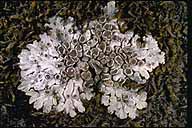 Squamarina lentigera is a characteristic
lichen on the high-gypsum soils of some desert areas. Sometimes individual
lichens end up on fragile little pedestals when soil is eroded away around
them.
Squamarina lentigera is a characteristic
lichen on the high-gypsum soils of some desert areas. Sometimes individual
lichens end up on fragile little pedestals when soil is eroded away around
them.
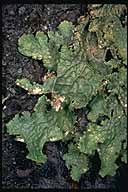 Lobaria oregana, which often
grows abundantly in the canopy of old-growth coniferous forests in the Northwest,
is a major nitrogen source. Timber-harvest schedules don't always allow
Lobaria to return to new trees before they are logged.
Lobaria oregana, which often
grows abundantly in the canopy of old-growth coniferous forests in the Northwest,
is a major nitrogen source. Timber-harvest schedules don't always allow
Lobaria to return to new trees before they are logged.
Ancient
forests and other undisturbed ecoysytems are vanishing from the world --
and with them the biological diversity that they sustain.
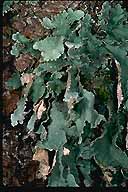 With more than 3600 species
in the United States and Canada, lichens are a major component of biological
diversity. Lichens, though, are extremely vulnerable to habitat alteration,
so it comes as no surprise that the habitats with the highest lichen species
diversity are the remnants of ancient forests and other undisturbed ecosystems.
With more than 3600 species
in the United States and Canada, lichens are a major component of biological
diversity. Lichens, though, are extremely vulnerable to habitat alteration,
so it comes as no surprise that the habitats with the highest lichen species
diversity are the remnants of ancient forests and other undisturbed ecosystems.
The association between high diversity of lichens and pristine habitiats is so clear that scientists use lichens as indicators of ecosystem continuity -- to help them identify areas that should be protected.
Certain lichen species grow primarily (or even exclusively)
in undisturbed habitats. Pseudocyphellaria rainierensis, for instance, grows
in the old-growth coniferous forests of the Pacific Northwest.
Environmental Studies using Lichens
Lichen ecologist Bruce McCune
takes inventory of lichens in a specialized habitat -- the tops of standing
dead trees in an old-growth forest. The Wind River Canopy Crane in southern
Washington "flies" scientists to research sites they cannot reach
in any other way.
Lichens are like little sponges that
take up everything that comes their way, including air pollution.
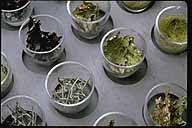 In a baseline air-quality study,
lichen specimens from the Tongass National Forest in Alaska were chemically
analysed to see what toxics were in the air.
In a baseline air-quality study,
lichen specimens from the Tongass National Forest in Alaska were chemically
analysed to see what toxics were in the air.
Most lichens
are extremely vulnerable to air pollution. When lichens disappear, they
give early warning of harmful conditions.
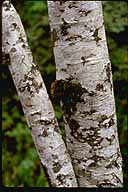
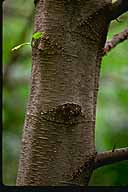 Red alder trees are usually
adorned with a mosaic of white lichens (left). Downwind of the smoke plume
from the Sitka Pulp Mill in Sitka, Alaska (which has since been closed),
no lichens could survive at all (right).
Red alder trees are usually
adorned with a mosaic of white lichens (left). Downwind of the smoke plume
from the Sitka Pulp Mill in Sitka, Alaska (which has since been closed),
no lichens could survive at all (right).
Scientists using lichens to monitor air quality often compare
current lichen inventories with past records. Nearly 80% of the original
lichen species were found to be missing from the Indiana Dunes National
Lakeshore.
Go to Lichen Vocabulary (A discussion of lichen growth forms and structures)
|